商务英语基础Unit1IntroductionsandGreetings介绍与问候
- 格式:pptx
- 大小:506.97 KB
- 文档页数:20
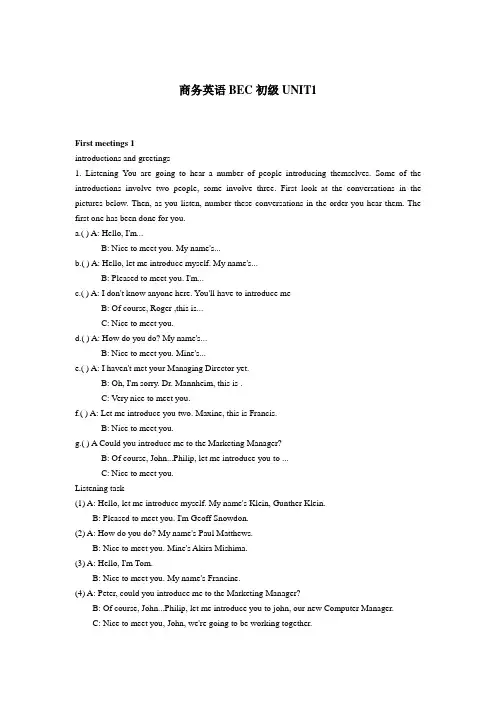
商务英语BEC初级UNIT1First meetings 1introductions and greetings1. Listening You are going to hear a number of people introducing themselves. Some of the introductions involve two people, some involve three. First look at the conversations in the pictures below. Then, as you listen, number these conversations in the order you hear them. The first one has been done for you.a.( ) A: Hello, I'm...B: Nice to meet you. My name's...b.( ) A: Hello, let me introduce myself. My name's...B: Pleased to meet you. I'm...c.( ) A: I don't know anyone here. You'll have to introduce meB: Of course, Roger ,this is...C: Nice to meet you.d.( ) A: How do you do? My name's...B: Nice to meet you. Mine's...e.( ) A: I haven't met your Managing Director yet.B: Oh, I'm sorry. Dr. Mannheim, this is .C: Very nice to meet you.f.( ) A: Let me introduce you two. Maxine, this is Francis.B: Nice to meet you.g.( ) A Could you introduce me to the Marketing Manager?B: Of course, John...Philip, let me introduce you to ...C: Nice to meet you.Listening task(1) A: Hello, let me introduce myself. My name's Klein, Gunther Klein.B: Pleased to meet you. I'm Geoff Snowdon.(2) A: How do you do? My name's Paul Matthews.B: Nice to meet you. Mine's Akira Mishima.(3) A: Hello, I'm Tom.B: Nice to meet you. My name's Francine.(4) A: Peter, could you introduce me to the Marketing Manager?B: Of course, John...Philip, let me introduce you to john, our new Computer Manager.C: Nice to meet you, John, we're going to be working together.(5) A: Herr Tubingen, I haven't met your Managing Director yet.B: Oh, I'm sorry. Come and meet him. Dr Mannheim, this is Mr. Roberts. He's over from the States on a visit.C: Very nice to meet you, Mr. Roberts. How long are you here for?(6) A: Jane, I don't know anyone here. You'll have to introduce me.B: Of course, I'll introduce you to Roger first. He's the host...Roger, this is Susan. She's just moved to the area.C: Nice to meet you, Susan. Do you come from these parts?(7) A: Let me introduce you two. Maxine, this is Francis.B: Nice to meet you, Maxine. Are you an old friend of Tony's?C: Oh yes, Tony and I have known each other for years, haven't we?A: Yes, that's right.2.Prisentation Introductions often include thes steps:You heard two types of introduction:GreetingOr } introduction --> responserequest for introductionYou head two types of introduction:introducing yourselfintroducing some one elseNotes:1. Some introductions are more formal than others. The use of first names indicates informality.2. In English-speaking cultures, peolle usually shake hands on first meting.Now listen again and indicate whether the introdcution is formal(F) or informal(I). The first one has been done for you.Introduction 1 ( F) Introduction 2 ( )Introduction 3 ( ) Introduction 4 ( )Introduction 5 ( ) Introduction 6 ( )Introduction 7 ( )3. Contralled practiceComplete the introductions.(1). Peter King introduces himself to Jack Simpson:Peter King: Hello, My name's Peter KingJack Simpson: I'm Jack Simpson.(2). Philip introduces Sarah to James:Sarah: Philip, I Here. You'll have to .Philip: Of , I'll to James. He's an old friend of mine.James, Sarah, she's just joined the company.James: ,Sarah. Where do you come from?(3). Rod Burton introduces Pete Taylor to an important custome:Pete: Rod, I Mrs Rogers, the Purchasing Manager from Kentons.Rod: I'm . Come and meet her. Mrs Rogers, Pete Taylor, our Export Sales Manager.Mrs Rogers: What countries do you cover?(4). Klaus Fischer introduces himself to an American visitor:Klaus Fischer: How ? MyAmerican: . Brenda Cole.课文注释及词汇讲解* We are going to be working together.我们将在一起工作。
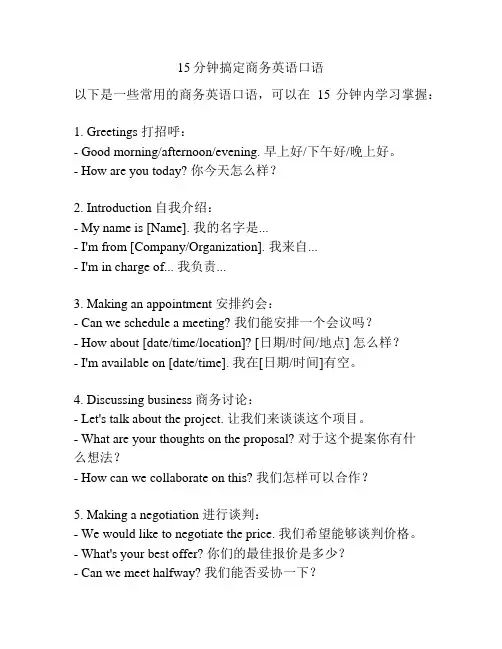
15分钟搞定商务英语口语以下是一些常用的商务英语口语,可以在15分钟内学习掌握:1. Greetings 打招呼:- Good morning/afternoon/evening. 早上好/下午好/晚上好。
- How are you today? 你今天怎么样?2. Introduction 自我介绍:- My name is [Name]. 我的名字是...- I'm from [Company/Organization]. 我来自...- I'm in charge of... 我负责...3. Making an appointment 安排约会:- Can we schedule a meeting? 我们能安排一个会议吗?- How about [date/time/location]? [日期/时间/地点] 怎么样?- I'm available on [date/time]. 我在[日期/时间]有空。
4. Discussing business 商务讨论:- Let's talk about the project. 让我们来谈谈这个项目。
- What are your thoughts on the proposal? 对于这个提案你有什么想法?- How can we collaborate on this? 我们怎样可以合作?5. Making a negotiation 进行谈判:- We would like to negotiate the price. 我们希望能够谈判价格。
- What's your best offer? 你们的最佳报价是多少?- Can we meet halfway? 我们能否妥协一下?6. Closing a deal 完成交易:- We have a deal. 我们达成协议。
- I'm happy with the terms. 我对条款感到满意。
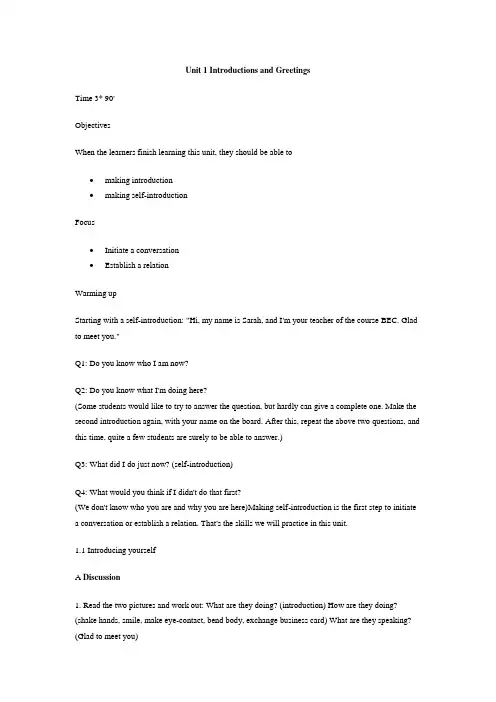
Unit 1 Introductions and GreetingsTime 3* 90'ObjectivesWhen the learners finish learning this unit, they should be able to∙making introduction∙making self-introductionFocus∙Initiate a conversation∙Establish a relationWarming upStarting with a self-introduction: "Hi, my name is Sarah, and I'm your teacher of the course BEC. Glad to meet you."Q1: Do you know who I am now?Q2: Do you know what I'm doing here?(Some students would like to try to answer the question, but hardly can give a complete one. Make the second introduction again, with your name on the board. After this, repeat the above two questions, and this time, quite a few students are surely to be able to answer.)Q3: What did I do just now? (self-introduction)Q4: What would you think if I didn't do that first?(We don't know who you are and why you are here)Making self-introduction is the first step to initiate a conversation or establish a relation. That's the skills we will practice in this unit.1.1 Introducing yourselfA Discussion1. Read the two pictures and work out: What are they doing? (introduction) How are they doing? (shake hands, smile, make eye-contact, bend body, exchange business card) What are they speaking? (Glad to meet you)2. Unlike in Chinese, self introduction in English is conducted in this way (on board):1) greeting (Hi)------presenting one's name (My name is/ I am XXX )------showing willingness for the meeting(nice to met you).2) respond with showing happiness(nice to met you, too)------- present one's name (My name is/ I am XXX ).B Listening & Demonstration.1. Listen to the tape and match the conversation to the pictures.Imitation is necessary as that can help student familiarize with verbal devices, and then facilitate later demonstration.2. DiscussionQ1: Is there any difference between the two dialogue? (Yes.)Q2: What is it? (The first is more formal than the second one.)3. Role play1) Practice with partner as at a business meeting where you are strangers to each other.2) Help is offered when needed but encouragement is more needed as students are not used to this practice, while some think this is too easy.4. Demonstration1) Ask students come to the stage to demonstrate. The first group should be the one who have not practiced seriously. By demonstration, they can realize that practice doesn't mean reading is enough.2) The later group should be volunteers.5. Discussion on demonstration with such questions:1) Is there any room for improving ?2) What suggestion would you make?6.Sum up the discussion:Not only verbal devices should be employed, non-verbal devices also are required in self introduction, such as hand shake, smile, bend body, offer business card, and etc.7. Demonstration again. Encourage those who have practiced do that again first, then others.C ListeningThe listening material is not tough at all but is can be designed as the base for later practice.1. Listen to the recording.2. After listening, all students are to give oneself a new name and put it on a slip. Collect the slip and then ask some one to take one of them and then start looking for the one bearing the name on the slip.3. Useful expression:Excuse me. Are you XXX?Sorry for interruption.That's alright.1.2 Saying where you are fromA Reading1. Read this advertisement and make the statements True or False.2. Check the answer.This reading material is not tough literally speaking. However for students, the name of certain cities or countries are of problem as they are seldom mentioned in their other textbooks. After finishing 1.2, the students should get an idea that as an international business person, one has to know the main business countries as well as their cultures, so they would try to collect such related information on their own.Suggested answer: 1) T, 2) T, 3) F, 4) T, 5) F, 6) T, 7) T, 8) F, 9) TB Listening1. Make sure of the requirement for this task -- Match the guests' names to the office.1) Read the name of the cities properly.2) Know ell the cities are located repectively.2. Listen to the tape twice.Suggested answer: 1) Moscow , 2) New York , 3) Colombia , 4) New Delhi ,5) New Delhi , 6) Beijing , 7) BrusselsC Role play1. Read the file on Page 116 and 118 respectively and make sure that the aim of the task is clear and well understood.2. Practice in pairs while teacher should tour round in the classroom and offer help in case it is needed. Encouragement is motivation.3. Demonstration and comment.1.3 Introducing other peopleA ListeningThis task is also easy in terms of literally devices, but doing that as role play could help students to see how badly skill practice they need.plete the conversation with the phrases in the box.1) Complete the conversation.2) Check the answer.Suggested answer: 1) How are you? 2) do you know Brian Turner? 3) He works in Milan .4) Please to meet you, Mr. Tokini. 5) Have a seat, Giovanni. 6) Cream and sugar, please.2. Role play based on the completed conversation.3. Discuss: Making introduction is a common practice in business career. How to do that? There are some tips:∙Introduce the visited one to the visiting one first.∙Introduce the junior positioned one to the senior one first.∙Introduce the younger one to the elder one first.∙Introduce the male to the female first.∙After conducting introduction, the introducer usually should find an excuse as to leave the new acquaintances to chat.B Language focus1.Study the examples in the box.2. Read the files on Page 63, Yuki's file, File 29 and 30, discuss which of the four would be favorable as candidates?C WritingLook at the pictures and work out what people are saying.This task is based on previous practice and it is always very easy for students majored in English.It can be taken as a relax as previous practice and discussion is some stressful.Sum-upIn this unit, we learnt:1. How to properly make a self introduction as to establish a relation.2. How to properly make others known to each other by an introduction.3. In communication, non-verbal devices are required.Assignment1. Role pay: group leader should see that every one in the group practices the skills of introduction and self introduction. ( A demonstration is to be made in next session).2. Learn all the names of countries and cities by heart.。
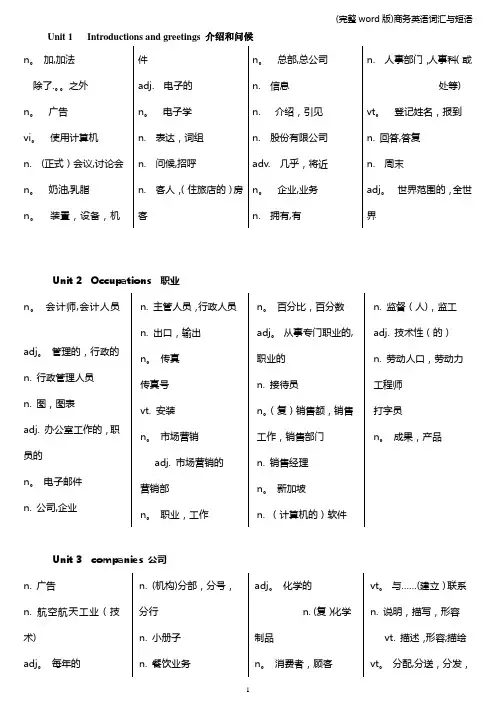
Unit 1 Introductions and greetings 介绍和问候n。
加,加法除了.。
之外n。
广告vi。
使用计算机n. (正式)会议,讨论会n。
奶油,乳脂n。
装置,设备,机件adj. 电子的n。
电子学n. 表达,词组n. 问候,招呼n. 客人,(住旅店的)房客n。
总部,总公司n. 信息n. 介绍,引见n. 股份有限公司adv. 几乎,将近n。
企业,业务n. 拥有,有n. 人事部门,人事科(或处等)vt。
登记姓名,报到n. 回答,答复n. 周末adj。
世界范围的,全世界Unit 2 Occupations 职业n。
会计师,会计人员adj。
管理的,行政的n. 行政管理人员n. 图,图表adj. 办公室工作的,职员的n。
电子邮件n. 公司,企业n. 主管人员,行政人员n. 出口,输出n。
传真传真号vt. 安装n。
市场营销adj. 市场营销的营销部n。
职业,工作n。
百分比,百分数adj。
从事专门职业的,职业的n. 接待员n。
(复)销售额,销售工作,销售部门n. 销售经理n。
新加坡n. (计算机的)软件n. 监督(人),监工adj. 技术性(的)n. 劳动人口,劳动力工程师打字员n。
成果,产品Unit 3 companies 公司n. 广告n. 航空航天工业(技术)adj。
每年的n. (机构)分部,分号,分行n. 小册子n. 餐饮业务adj。
化学的n. (复)化学制品n。
消费者,顾客vt。
与……(建立)联系n. 说明,描写,形容vt. 描述,形容;描绘vt。
分配,分送,分发,1分销n. 雇员,雇工vt. 把…装入信封(或包裹等),装有兹附上n. 工程学,工程n. 环境,生态环境vt.;vi. 出口n. (人造)纤维adj。
金融的,财政的金融服务n. (由若干企业或公司组成的)集团n. 保险adj. 有磁性的,有吸引力的n。
(尤指大量的)制造,制造业adj. 海的,航海的n。
(medium的复数)媒介物,新闻媒介adj。


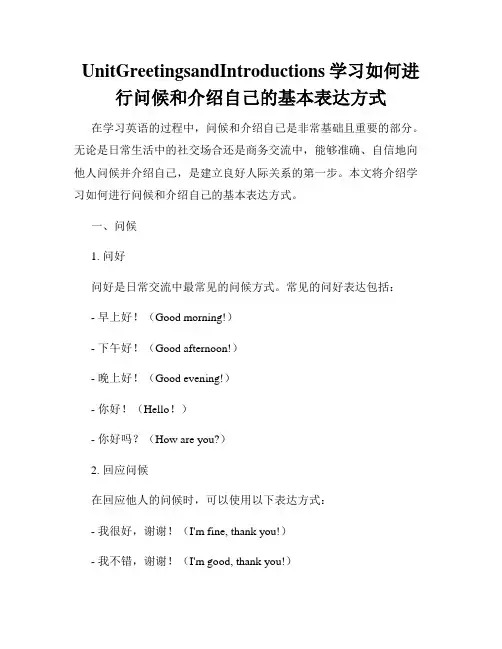
UnitGreetingsandIntroductions学习如何进行问候和介绍自己的基本表达方式在学习英语的过程中,问候和介绍自己是非常基础且重要的部分。
无论是日常生活中的社交场合还是商务交流中,能够准确、自信地向他人问候并介绍自己,是建立良好人际关系的第一步。
本文将介绍学习如何进行问候和介绍自己的基本表达方式。
一、问候1. 问好问好是日常交流中最常见的问候方式。
常见的问好表达包括:- 早上好!(Good morning!)- 下午好!(Good afternoon!)- 晚上好!(Good evening!)- 你好!(Hello!)- 你好吗?(How are you?)2. 回应问候在回应他人的问候时,可以使用以下表达方式:- 我很好,谢谢!(I'm fine, thank you!)- 我不错,谢谢!(I'm good, thank you!)- 你呢?(And you?)二、介绍自己1. 自我介绍自我介绍是和他人初次见面时常用的表达方式。
在自我介绍时,可以提供以下必要信息:- 姓名(My name is...)- 年龄(I am...years old.)- 国籍(I am from...)- 职业(I am a...)- 个人兴趣爱好(I am interested in...)- 目前所从事的工作(I am currently working as...)2. 询问他人信息在与他人交流时,为了更好地了解对方,可以使用以下表达方法询问他人信息:- 你叫什么名字?(What's your name?)- 你几岁了?(How old are you?)- 你来自哪个国家?(Where are you from?)- 你是做什么工作的?(What do you do for a living?)- 你有什么兴趣爱好?(What are your hobbies?)三、其他常用问候和介绍方式1. 打招呼- 很高兴认识你!(Nice to meet you!)- 非常愉快!(Pleased to meet you!)- 您好!(Good to see you!)2. 友好交流- 有空时我们可以一起出去吃饭。
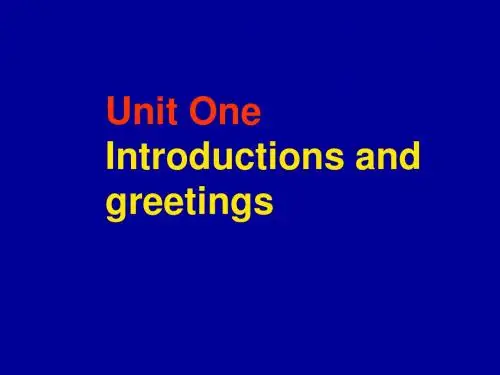
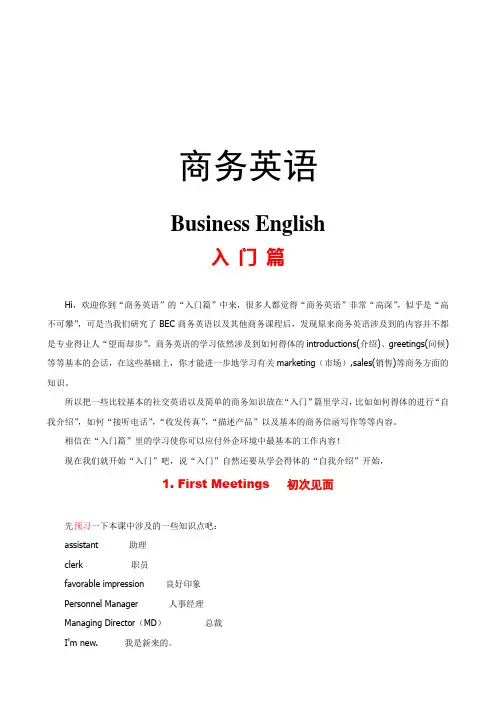
商务英语Business English入门篇Hi,欢迎你到“商务英语”的“入门篇”中来,很多人都觉得“商务英语”非常“高深”,似乎是“高不可攀”,可是当我们研究了BEC商务英语以及其他商务课程后,发现原来商务英语涉及到的内容并不都是专业得让人“望而却步”,商务英语的学习依然涉及到如何得体的introductions(介绍)、greetings(问候)等等基本的会话,在这些基础上,你才能进一步地学习有关marketing(市场),sales(销售)等商务方面的知识。
所以把一些比较基本的社交英语以及简单的商务知识放在“入门”篇里学习,比如如何得体的进行“自我介绍”,如何“接听电话”,“收发传真”,“描述产品”以及基本的商务信函写作等等内容。
相信在“入门篇”里的学习使你可以应付外企环境中最基本的工作内容!现在我们就开始“入门”吧,说“入门”自然还要从学会得体的“自我介绍”开始,1. First Meetings 初次见面先预习一下本课中涉及的一些知识点吧:assistant 助理clerk 职员favorable impression 良好印象Personnel Manager 人事经理Managing Director(MD)总裁I'm new.我是新来的。
to be working together. 我们将一起工作。
to look forward to doing sth. 盼望做某事初次见面用语:Nice to meet you.很高兴见到你。
告别时用语:It was very nice to have met you. 能见到你我真高兴Hope to see you again. 希望能再次见到你。
第一天到公司上班,You must be nervous.你的心情一定挺紧张。
怎么才能给上级和同事留下 a favorable impression(良好印象)呢?西装革履的你看起来很cool,但你还是没有十分的把握。
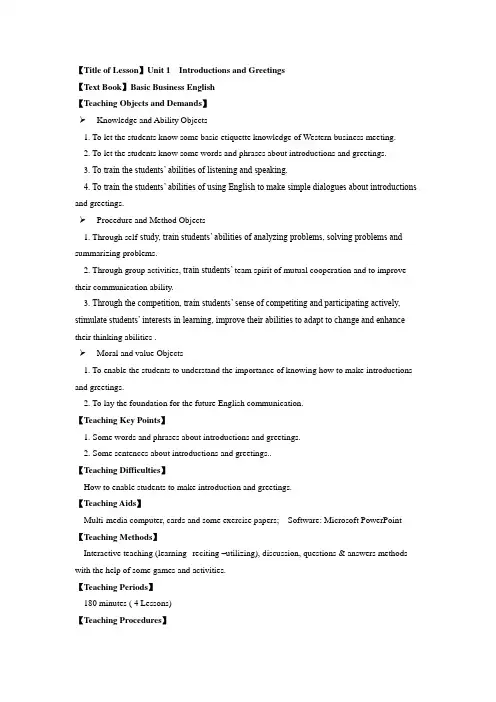
【Title of Lesson】Unit 1 Introductions and Greetings【Text Book】Basic Business English【Teaching Objects and Demands】➢Knowledge and Ability Objects1. To let the students know some basic etiquette knowledge of Western business meeting.2. To let the students know some words and phrases about introductions and greetings.3. To train the students’ abilities of listening and speaking.4. To train the students’ abilities of using English to make simple dialogues about introductions and greetings.➢Procedure and Method Objects1. Through self-study, train students’ abilities of analyzing problems, solving problems and summarizing problems.2. Through group activities, train students’ team spirit of mutual cooperation and to improve their communication ability.3. Through the competition, train students’ sense of competiting and participating actively, stimulate students’ interests in learning, improve their abilities to adapt to change and enhance their thinking abilities .➢Moral and value Objects1. To enable the students to understand the importance of knowing how to make introductions and greetings.2. To lay the foundation for the future English communication.【Teaching Key Points】1. Some words and phrases about introductions and greetings.2. Some sentences about introductions and greetings..【Teaching Difficulties】How to enable students to make introduction and greetings.【Teaching Aids】Multi-media computer, cards and some exercise papers; Software: Microsoft PowerPoint 【Teaching Methods】Interactive teaching (learning--reciting –utilizing), discussion, questions & answers methods with the help of some games and activities.【Teaching Periods】180 minutes ( 4 Lessons)【Teaching Procedures】Step 1: Lead-in1. Through questions and answers to lead in new lesson. Such as:T(Teacher): How do you do?Ss(Students): How do you doT: How are you today?Ss: Fine, thank you, and you?T: I’m fine, too.T: This is the way to do some introductions and greeting. You know ,when you meet someone you don’t know, you will introduce yourself or be introduced by others, when you meet someone you know, you will greet with others. So Making introductions and greeting in daily life is very important ,today we will learn about introductions and greetings.2. Explaining in details the differences about introductions and greetings between the Chinese custom and the Western custom.Aim:By questions and answers to lead in the lesson directly and let Ss know the task of this lesson clearly. To encourage Ss to think and express their own ideas freely to arouse their interests.Step 2: Listening and speaking【Teacher’s words】I have explained something about introductions and greeting. Now let’s listen carefully how do they make introduction in the dialogue.1. Listening ActivityA. Listen to the dialogue for the first time and do Task One: repeat the sentences on the screen together.B. Divide the class into several groups and ask the students to do listening activity: Listen to the dialogue carefully ,discuss in groups and do Task Two together. Ask Ss to say their answers out, one student each group as the representative.C. The teacher checks the students’ answers and shows out the correct answers on PPT.D. Listen to the dialogue for the last time and do Task three: answer the questions showed on the screen.Aim: Through Listening Activity repeatedly to let Ss be active in thinking and train their abilities of listening and cooperation.2. Speaking Activity【Teacher’s words】Now we have learned some words and patterns about how to make introductions and greetings.Next we will do pairworks according to the following situations: A. PPT shows two situations and some useful knowledge:Situation 1: Mr. Brown, 29 year old, employee in Customer Service Department. Mr. Tones, 40 year old, employee in Personnel Department.Situation 2: Louise Scott, female, General Manager of your company.Mike Johnson, male, VIP of your company, sales manager of SWQ Ltd.Useful knowledge:Let me introduce …to you.This is…She / He is …B. Two Ss a group. One student acts as a secretary in a foreign trade company to make introduction to your partner. Then change the roles .Aim:Through the Speaking Activity to train Ss’s skills of listening and speaking and abilities of using languang.Step3. Business Reading1. Learning the text【Teacher’s words】Just now we learn something about making an introduction in daily life.Now we’d like to learn some correct ways of making a business in troduction. This step we will do self-study activity , Guess game(猜一猜游戏),Choosing Game (选一选游戏)and Filling Game(填一填游戏):(1) Self-studying ActivityA. Give Ss 5 Mins to self-study the text with three Pre-reading Questions:1. Why should we pay more attention to the introductions?2. What are the basic rules in business introductions?3. What should you do to respond to the introduction properly?B. Ask Ss to answer the questions.C. Let Ss explain the meaning of the text one sentence by one sentence.D. Teacher checks.E. Ss read the text together.(2) Guessing GameA. PPT shows some key words, phrases and sentences.B. Ask Ss to do contest of guessing the meanings one by one.C. Teacher checks.D. Ss read the key words,phrases and sentences together.(3)Choosing GameA. PPT shows four sentences about the text.B. Ask Ss to choose “True or False” one by one.C. Teacher checks..(4)Filling GameA. PPT shows eight words and eight sentences with one blank each.B. Ask Ss to fill the words in the blanks of the sentences.C. Teacher checks.D. Ss read the completed sentences together.Aim:Through self-study activity and Guess game to let Ss know the meaning of text about making an introduction, master some useful words, phrases and sentences. And by reading the text to train the students’ reading abilities and let Ss pay attention to their pronunciations.2. Games for Grammar【Teacher’s words】: In this step we will do two games: Finding-home Game(快乐找家家游戏) and Choosing Game(选一选游戏). In Finding-home Game two houses with common nouns and proper nouns written on them will be shown on PPT, then show out many words quickly, let Ss check and find the homes for these nouns quickly. The group which finds the home for the most words correctly wins. In Choosing Game four choices for each sentence will be shown on PPT, and then let Ss choose the correct answers one group by one group. The group which work out the most sentences correctly wins.(1)Finding-home Game(快乐找家家游戏)A. PPT shows two homes with common nouns and proper nouns written on them.B. Then show out many words quickly.C. Let Ss check and find the homes for these nouns quickly.D. Teacher checks the answers.(2) Choosing Game(选一选游戏)A.PPT shows four choices for each sentence.B.Then let Ss choose the correct answers one group by one group.C.Teacher checks the answers.Aim: Through this step of Games for Grammar to let Ss study and review grammar knowledge about nouns happily and unconsciously. And train the Ss’s being active in thinking questions and finding the answers for the questions, enhance their skills of speaking and translating.Step 4: Consolidation and Summary【Teacher’s words】: In this step we will do many practices activities to consolidate and sum something we learn in this lession.(1)Let Ss do the exercises “Complete the following sentences with the Chinese given(words)in the brackets.” to consolidate the grammar of nouns.(2)Let Ss do the exercises “Translate the following sentences into Chinese.”, “Cloze.” And “Writing.” to expand Ss knowledge of making a business introduction.Aim: Through many exercises to do summary and consolidation to this lesson make Ss review and master the knowledge which we learn in this lesson. emphasizes the key points and difficult points of this lesson again so as to let Ss know the importance of making an introduction further.Step 5: Homework【Teacher’s words】: Here there are four homeworks. Each student must do the first ,second and third. And Ss have the right to decide whether he will do or not do the fourth one by themselves.1. Read and recite the new words and expressions.2. Read the text fluently.3. Act as roles to make dialogues with your partners.4. Search more knowledge about making a business introduction in Western countries.Aim: Through assignment by levels to let Ss choose their homeworks by themselves to encourage Ss to analyze themselves, improve Ss’ abilities of listening,speaking and reading further and train Ss’ abilities of communicating with others.。

日常商务英语简单的职场英语用语在职场中,正确地运用商务英语是非常重要的,能够提高工作效率、加强合作与沟通。
本文将介绍一些简单的职场英语用语,帮助您在工作中更加顺利地与同事、客户交流。
1. Greetings and Introductions 问候和介绍- Good morning/afternoon/evening. 早上好/下午好/晚上好。
- How are you? 你好吗?- Nice to meet you. 很高兴见到你。
- May I introduce myself? 我能自我介绍一下吗?- Let me introduce you to my colleague, Mr./Ms. Smith. 让我向你介绍我的同事史密斯先生/女士。
2. Requesting Information 请求信息- Could you please provide me with the latest sales report? 你可以提供最新的销售报告吗?- I would like to know the status of the project. 我想了解项目的进展情况。
- Can you give me more details about that? 你能给我更多关于那个的细节吗?- Would you mind clarifying this point for me? 你介意给我澄清一下这个问题吗?3. Providing Information 提供信息- Here is the information you requested. 这是你要求的信息。
- We have completed the project on time. 我们按时完成了这个项目。
- I can give you a brief overview of our company. 我可以给你简要介绍一下我们公司。
商务英语Unit1IntroductionsandgreetingsUnit 1 Introductions and GreetingsTime 3* 90'ObjectivesWhen the learners finish learning this unit, they should be able tomaking introductionmaking self-introductionFocusInitiate a conversationEstablish a relationWarming upStarting with a self-introduction: "Hi, my name is Sarah, and I'm your teacher of the course BEC. Glad to meet you."Q1: Do you know who I am now?Q2: Do you know what I'm doing here?(Some students would like to try to answer the question, but hardly can give a complete one. Make the second introduction again, with your name on the board. After this, repeat the above two questions, and this time, quite a few students are surely to be able to answer.)Q3: What did I do just now? (self-introduction)Q4: What would you think if I didn't do that first?(We don't know who you are and why you are here)Making self-introduction is the first step to initiate a conversation or establish a relation. That's the skills we will practice in this unit.1.1 Introducing yourselfA Discussion1. Read the two pictures and work out: What are they doing?(introduction) How are they doing? (shake hands, smile, make eye-contact, bend body, exchange business card) What are they speaking? (Glad to meet you)2. Unlike in Chinese, self introduction in English is conducted in this way (on board):1) greeting (Hi)------presenting one's name (My name is/ I am XXX )------showing willingness for the meeting(nice to met you).2) respond with showing happiness(nice to met you, too)------- present one's name (My name is/ I am XXX ).B Listening & Demonstration.1. Listen to the tape and match the conversation to the pictures.Imitation is necessary as that can help student familiarize with verbal devices, and then facilitate later demonstration.2. DiscussionQ1: Is there any difference between the two dialogue? (Yes.) Q2: What is it? (The first is more formal than the second one.)3. Role play1) Practice with partner as at a business meeting where you are strangers to each other.2) Help is offered when needed but encouragement is more needed as students are not used to this practice, while some think this is too easy.4. Demonstration1) Ask students come to the stage to demonstrate. The first group should be the one who have not practiced seriously. By demonstration, they can realize that practice doesn't mean reading is enough.2) The later group should be volunteers.5. Discussion on demonstration with such questions:1) Is there any room for improving ?2) What suggestion would you make?6.Sum up the discussion:Not only verbal devices should be employed, non-verbal devices also are required in self introduction, such as hand shake, smile, bend body, offer business card, and etc.7. Demonstration again. Encourage those who have practiced do that again first, then others.C ListeningThe listening material is not tough at all but is can be designed as the base for later practice.1. Listen to the recording.2. After listening, all students are to give oneself a new name and put it on a slip. Collect the slip and then ask some one to take one of them and then start looking for the one bearing the name on the slip.3. Useful expression:Excuse me. Are you XXX?Sorry for interruption.That's alright.1.2 Saying where you are fromA Reading1. Read this advertisement and make the statements True or False.2. Check the answer.This reading material is not tough literally speaking. However for students, the name of certain cities or countries are of problem as they are seldom mentioned in their other textbooks. After finishing 1.2, the students should get an idea that as aninternational business person, one has to know the main business countries as well as their cultures, so they would try to collect such related information on their own.Suggested answer: 1) T, 2) T, 3) F, 4) T, 5) F, 6) T, 7) T, 8) F, 9) TB Listening1. Make sure of the requirement for this task -- Match the guests' names to the office.1) Read the name of the cities properly.2) Know ell the cities are located repectively.2. Listen to the tape twice.Suggested answer: 1) Moscow , 2) New York , 3) Colombia ,4) New Delhi ,5) New Delhi , 6) Beijing , 7) BrusselsC Role play1. Read the file on Page 116 and 118 respectively and make sure that the aim of the task is clear and well understood.2. Practice in pairs while teacher should tour round in the classroom and offer help in case it is needed. Encouragement is motivation.3. Demonstration and comment.1.3 Introducing other peopleA ListeningThis task is also easy in terms of literally devices, but doing that as role play could help students to see how badly skill practice they need./doc/13742471.html,plete the conversation with the phrases in the box.1) Complete the conversation.2) Check the answer.Suggested answer: 1) How are you? 2) do you know BrianTurner? 3) He works in Milan .4) Please to meet you, Mr. Tokini. 5) Have a seat, Giovanni. 6) Cream and sugar, please.2. Role play based on the completed conversation.3. Discuss: Making introduction is a common practice in business career. How to do that? There are some tips: Introduce the visited one to the visiting one first.Introduce the junior positioned one to the senior one first.Introduce the younger one to the elder one first.Introduce the male to the female first.After conducting introduction, the introducer usually should find an excuse as to leave the new acquaintances to chat.B Language focus1.Study the examples in the box.2. Read the files on Page 63, Yuki's file, File 29 and 30, discuss which of the four would be favorable as candidates?C WritingLook at the pictures and work out what people are saying.This task is based on previous practice and it is always very easy for students majored in English.It can be taken as a relax as previous practice and discussion is some stressful.Sum-upIn this unit, we learnt:1. How to properly make a self introduction as to establish a relation.2. How to properly make others known to each other by an introduction.3. In communication, non-verbal devices are required.Assignment1. Role pay: group leader should see that every one in the group practices the skills of introduction and self introduction. ( A demonstration is to be made in next session).2. Learn all the names of countries and cities by heart.。
Unit 1 Introductions and greetings介绍和问候本课重点:自我介绍和介绍日常问候学习意义:1 由于不同的文化,汉语的自我介绍方式与日常问候都和英语的不同。
作为国际商务人士,能娴熟运用英语作自我介绍及进行寒暄不但令当事人有自信,也有益于拓展商务合作关系或自我发展。
2 尽管同学们曾在一开始学习英语时就学习了如何介绍自己和别人以及日常问候的句型,似乎在语言点上无需再重复。
但实际上由于生活环境、经历和本土文化影响,我们的同学很少在实际生活中运用英语介绍自己和他人的技巧。
即使做类似联系也多是面对同学,只求语言流畅,语音正确。
但在商务英语课程中,介绍和问候被看作一种综合技能来训练,要求学生不仅能流畅准确地说出,还要求学生能正确的表达——即正确运用在从事这些活动时情景必需的身体语言和表情,能具备国际商务交往中基本的交际能力。
3 熟悉一些主要的商业国家和城市。
学习建议:1.注意观察教师的示范,并按要求与同座进行练习。
在练习时应尽可能与对方保持一米左右距离,这样才能提醒自己声音清晰,否则对方无法听清。
提醒自己进入角色,在进行介绍和问候时要与对方保持目光接触、面带微笑,握手时身体略前倾。
如没把握,可观摩同学的练习或请求教师予以指导。
2.和对方各自为自己起一英语名并不让对方知道,将英语名写于纸上后再与对方一起练习自我介绍和问候。
然后各自将听得对方的姓名写下交对方检验是否正确。
这个练习的目的是促使学习者能下意识要求自己能语音清晰、举止大方的与人交谈,还能有礼貌的倾听对方,有效获取信息。
3.主动要求在班上示范,这样能帮助掌握社交基本技巧,也能逐步获得自信,为今后的课堂活动和商务实践打下较好的基础。